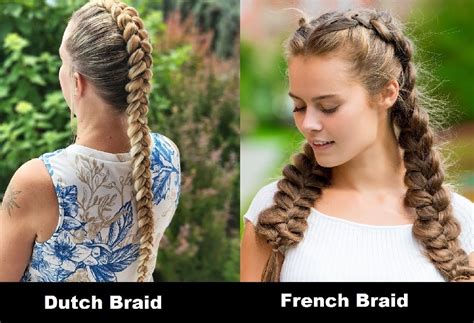Introduction: A Tale of Two Braids
In the realm of hairstyling, braids hold an esteemed place. From the classic French braid to the intricate Dutch braid, these timeless techniques have been captivating hearts for centuries. But when it comes to choosing between these two iconic braids, which one reigns supreme? Let’s dive into a comprehensive comparison to uncover the secrets that lie within each weave.

Dutch Braid: Unveiling the Dutch Delight
The Dutch braid, also known as the “inside-out braid,” stands out with its unique construction. Unlike its French counterpart, the Dutch braid weaves strands from the underneath rather than the top. This inverted approach creates a distinct raised effect, adding volume and texture to any coiffure.
Origins: The Dutch braid traces its roots back to the Netherlands, where it was traditionally worn by women in rural areas. Its practical nature made it ideal for keeping hair out of the way during daily tasks.
Technique: Mastering the Dutch braid requires precision and practice. The key lies in crossing the lower strands over the upper strands, creating a criss-cross pattern that gives the braid its characteristic appearance.
Advantages:
- Volume: The Dutch braid excels in adding volume to even the finest hair.
- Texture: Its raised effect creates a stunning texturized look that can elevate any hairstyle.
- Hold: Due to its tight construction, the Dutch braid offers excellent hold, making it suitable for all-day wear.
Disadvantages:
- Tension: The Dutch braid can put tension on the scalp, especially if pulled too tightly.
- Time-consuming: Compared to the French braid, the Dutch braid requires a bit more time to create.
French Braid: Exploring the French Finesse
The French braid, a cornerstone of hairstyling, is renowned for its elegance and versatility. Its classic three-strand construction, interwoven from the top, exudes sophistication and timeless charm.
Origins: As its name suggests, the French braid originated in France during the 17th century. It quickly gained popularity among women of all ages and social classes.
Technique: The French braid involves dividing the hair into three sections and crossing the outer strands over the middle strand sequentially. By adding small sections of hair from the sides with each pass, the braid gradually grows in size.
Advantages:
- Elegance: The French braid epitomizes classic elegance and sophistication.
- Versatility: Its timeless appeal makes it suitable for various occasions, from formal events to casual outings.
- Quick and easy: Mastering the French braid is relatively easy compared to the Dutch braid.
Disadvantages:
- Flatness: The French braid sits flatter against the scalp, which may not suit all hair types.
- Less volume: Unlike the Dutch braid, the French braid adds less volume to the hair.
Comparative Analysis: A Braid-to-Braid Breakdown
Now that we’ve examined each braid individually, let’s delve into a detailed comparative analysis to identify their key differences:
| Feature | Dutch Braid | French Braid |
|---|---|---|
| Construction | Strands crossed underneath | Strands crossed on top |
| Effect | Raised and textured | Flatter and smoother |
| Volume | Adds significant volume | Adds less volume |
| Hold | Excellent hold | Good hold |
| Tension on scalp | Can cause tension if pulled too tightly | Less tension on scalp |
| Time to create | More time-consuming | Relatively quick and easy |
Applications: Braiding Beyond the Basics
The versatility of both Dutch and French braids extends far beyond traditional hair styling. These techniques can be creatively applied to various realms, unlocking a world of possibilities:
- Textile Design: The intricate patterns of Dutch and French braids can inspire unique textile designs for clothing, accessories, and home décor.
- Jewelry Making: Braiding techniques can be used to create intricate jewelry pieces, such as bracelets, necklaces, and earrings.
- Home Decor: Braided cords and ribbons can add texture and style to curtains, drapes, and throw pillows.
- Packaging Design: The raised effect of Dutch braids can create visually appealing packaging for products such as soaps, candles, and gift boxes.
Tips and Tricks: Braid Like a Pro
Mastering the art of Dutch and French braids requires patience and practice. Here are some expert tips to elevate your braiding skills:
- Brush your hair thoroughly: Removing tangles ensures a smooth and even braid.
- Divide hair into equal sections: This creates a balanced and symmetrical braid.
- Keep your strands taut: Maintaining tension throughout the braiding process prevents loose or sloppy braids.
- Use products: A light-hold hairspray or mousse can add volume and hold to your braids.
- Practice, practice, practice: Repetition is key to becoming a proficient braider.
Conclusion: The Winner’s Crown
So, which braid emerges victorious from this epic showdown? Ultimately, the best braid depends on your personal style and preference.
If you crave volume, texture, and a standout look, the Dutch braid reigns supreme. Its raised effect and intricate construction make it an ideal choice for adding drama to any hairstyle.
However, if you prefer classic elegance and versatility, the French braid remains a timeless favorite. Its smooth, refined appearance makes it suitable for both formal and casual occasions.
Whether you choose the Dutch braid’s bold statement or the French braid’s effortless chic, embrace the artistry of braiding and unlock the endless possibilities that these iconic techniques have to offer.
